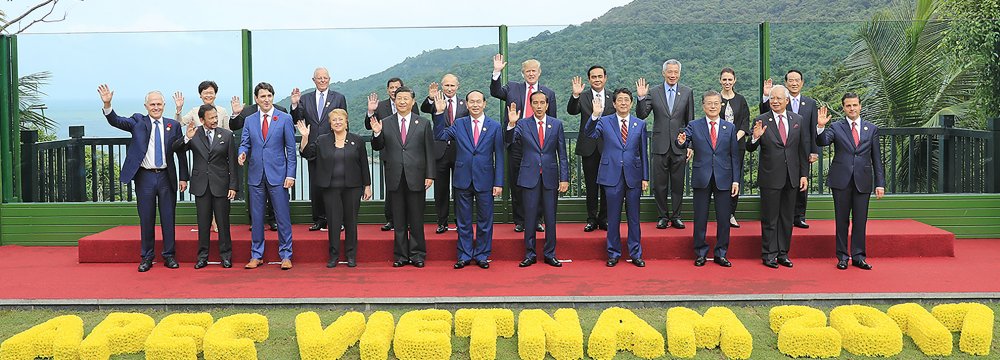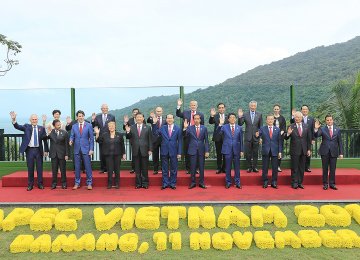An annual Pacific Rim summit is sticking with its tradition of promoting free trade and closer regional ties, shrugging off President Donald Trump's "America First" approach.
Draft documents issued Saturday by ministers of the 21-member Asia-Pacific Economic Cooperation forum omitted the leaders' usual vow to combat protectionism, but still expressed support for "free and open trade and investment" and for institutions such as the World Trade Organization, AP reported.
Trade ministers from 11 Pacific Rim countries announced an agreement on pushing ahead with a free-trade deal whose destiny was uncertain after Trump dropped it.
Revisions of the deal to allow the remaining 11 countries to proceed without US involvement involved a difficult balance between maintaining high standards and pragmatism, Japanese Economy Minister Toshimitsu Motegi said after late-night talks culminated in a preliminary agreement.
“The substance is something all the Trans-Pacific Partnership countries can agree on,” said Motegi. “This will send a very strong message to the US and the other countries in the region.”
The ministers dropped key provisions the Americans had required on protection of intellectual property, among others. They also changed the trade accord’s name to the unwieldy Comprehensive and Progressive Agreement for Trans-Pacific Partnership.
More work needs to be done for the agreement to be endorsed by leaders of the member countries at some unspecified point in the future, the joint statement said.
The statement still refers to free and open trade and to recognizing the world of the World Trade Organization, but it also refers to fair trade and to members “improving adherence to rules agreed upon.”
A reference to strengthening the multilateral trading system was dropped. The ministers also said they would work to improve the functioning of the WTO—which Trump criticized in Friday’s speech.
Leaving the US Behind
Trump had taken a strongly different stance on trade to predecessors with an emphasis on an “America First” policy that he says will protect American jobs and mean other countries do not take advantage of the United States, Reuters reported.
The discussion over the statement in Danang, Vietnam, has been similar to that which took place at Group of 20 meetings where the Trump administration demanded changes to the usual language.
Countries in the TPP trade deal have agreed on the core elements to move ahead without the United States, officials said on Saturday, after last-minute resistance from Canada raised new doubts about its survival.
“We have overcome the hardest part,” Vietnam’s trade minister, Tran Tuan Anh, told a news conference. The agreement still needs to be finalized, he said.
Motegi said he hoped that moving ahead with the deal would be a step towards bringing back the United States.
Partly to counter China’s growing dominance in Asia, Japan had been lobbying hard for the TPP pact, which aims to eliminate tariffs on industrial and farm products across the 11-nation bloc whose trade totaled $356 billion last year.
Some 20 provisions of the original agreement were suspended. Those included some related to protecting labor rights and the environment, although most were related to intellectual property—one of the main sticking points after the US withdrawal.
“The overall impact on most firms is quite modest,” said Deborah Elms of the Asian Trade Center think-tank, adding that the new version was “essentially identical to the original document”.
Global Uncertainties
Global uncertainties facing free and open trade have been impeding regional integration, Vietnam President Tran Dai Quang said on the opening day of the 25th annual meeting, urging APEC leaders to find ways to ensure that the benefits of globalization and economic integration are equally distributed.
“Within a year since our last meeting in Peru, we have witnessed more rapid and complex changes that we expected,” Quang, chair of the APEC Economic Leaders’ Meeting, said, pointing to the unfolding world security and economic and social challenges that threaten the momentum of trade and growth recovery.
“This requires APEC to uphold its leadership in finding new drivers for growth, trade, investment, connectivity and in finding ways to ensure that the benefits of globalization and economic integration are equally distributed.”
APEC’s members are Australia, Brunei, Canada, Chile, China, Hong Kong, Indonesia, Japan, South Korea, Malaysia, Mexico, New Zealand, Papua New Guinea, Peru, Philippines, Russia, Singapore, Taiwan, Thailand, US and Vietnam.






Add new comment
Read our comment policy before posting your viewpoints